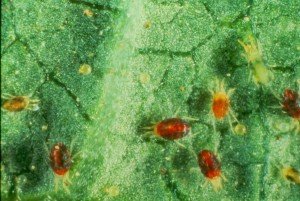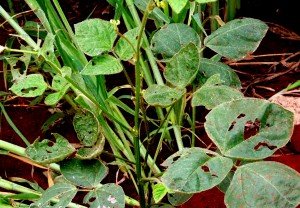Two spotted mites (TSM) or red spider mites have been reported in damaging numbers in many mungbean crops on the Darling Downs and in Northern NSW. Crops at particular risk are those adjacent to maturing cotton (or any other mite hosts) from which mites are dispersing in large numbers. As TSM are very small (0.5 mm) the first evidence of their presence is usually the damage symptoms which consist of fine stippling and webbing on the leaves. Heavy infestations will result in leaf desiccation, leaf drop, and yield loss.
The mites themselves are pale green with two dark spots (summer form), or red (end of season or overwintering form). Please note that two spotted mites and red spider mites are the same species. In view of the mite reports to date, all mungbean crops adjacent to potential earlier maturing crops should be checked for TSM.
No miticides are currently registered in mungbeans so the only options for mite-infested mungbeans are crop oils such as Canopy. Canopy is a more expensive crop oil option but is less likely to burn crops than cheaper products which don’t contain a ULV protectant. The recommended Canopy rate is 2-3%, the lower rate is recommended if a repeat spray is required. Note that 2-3% equates to 20-30 mLs per litre of water or 2-3L/ha where the total spray volume is 100L/ha.
Thorough spray coverage is essential with crop oils which can take up to one week to suppress mite populations. If there is sustained mite pressure, which is often the case where mungbeans are adjacent to a mite source (e.g. cotton crops), repeat sprays may be necessary at 14 day intervals. The action threshold is 30% of plants being infested.
Mites are easily flared through the injudicious use of non selective pesticides against other pests. Pre-flowering helicoverpa infestations can be controlled with virus biopesticides such as VivusMax and Gemstar. The latest guidelines for such products are to apply them only when in-crop temperatures are higher than 180C, and ideally when higher than 250C. Alkaline spray tank water should be buffered with a buffering agent such as Li700. For effective control, it is critical that helicoverpa larvae are detected while still small, i.e. no more than 7 mm in length, and that thorough spray coverage is achieved. Remember that the above virus products only target helicoverpa caterpillars.
To control helicoverpa during the flowering/podding stage use indoxacarb (Steward EC) which is more selective than older non selective pesticides such as methomyl, thiodicarb and the synthetic pyrethroids. However do not mix Steward EC with Canopy as there are reports of the Steward EC settling out and blocking spray nozzles and filters.
Dimethoate sprays to control mirids are highly likely to flare mites. To minimise the mite risk, consider applying a low rate of dimethoate (200-250 mL/ha) with a 0.5% salt adjuvant. These rates have both proven efficacy against mirids but a greatly reduced impact on beneficial insects.
Spraying podsucking bugs with deltamethrin (the only registered insecticide for this pest) is also likely to flare mites. To minimise the mite risk, delay spraying until pods are starting to fill.
Article by Hugh Brier and Kate Charleston


